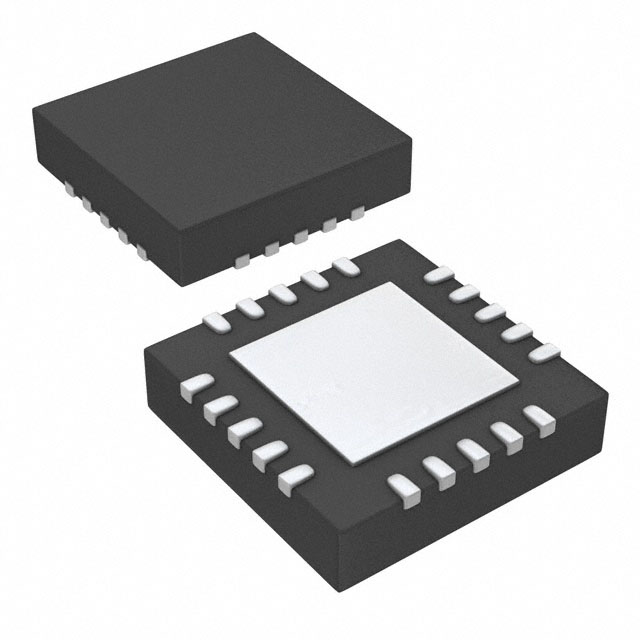Understanding CC1101RGPR for Wireless Remote Control Systems

The CC1101RGPR is a small, low-energy RF module for wireless communication, making it an essential component in the CC1101RGPR-based wireless remote control and security alarm system development program. It enables remote control systems to send data reliably and efficiently while consuming less power than the SX1231. Although the SX1231 offers better signal sensitivity and stronger transmission, the CC1101RGPR's energy-saving features are ideal for critical applications.
In security systems, the CC1101RGPR facilitates safe communication between devices, enhancing overall protection. It plays a vital role in programs aimed at developing wireless remote controls and alarm systems. With its robust performance, the CC1101RGPR ensures that homes and businesses remain secure and operate smoothly.
Key Takeaways
The CC1101RGPR is a low-energy radio module used for wireless communication in remote controls and security systems.
It works well across many frequencies, making it great for smart homes and IoT gadgets.
Setting it up correctly is important; connect power, SPI pins, and the antenna properly for the best performance.
Don’t make mistakes like using the wrong power supply or having loose wires to keep communication steady.
Check and take care of your CC1101RGPR system often to make sure it works well in all conditions.
Technical Specifications of CC1101RGPR
Overview of the CC1101RGPR module
The CC1101 is a small, low-power RF chip. It works for wireless communication in sub-1 GHz frequencies. You can use it to make systems that save energy. These systems are great for remote control and sending data. Its small size and low power use are perfect for battery devices. This chip supports many ways to send signals, making it flexible. Whether for smart homes or IoT, the CC1101 is a strong choice.
Key features and capabilities
The CC1101 has great technical features. Here’s a quick look:
Specification | Details |
|---|---|
Maximum Data Rate | 600 kbps |
Frequency Ranges | 300 MHz to 348 MHz, 387 MHz to 464 MHz, 779 MHz to 928 MHz |
Supply Voltage Range | 1.8V to 3.6V |
Operating Temperature Range | -40°C to 85°C |
Supported Modulation Schemes | 2FSK, 4FSK, ASK, GFSK, MSK, OOK |
This chip uses little power while working well. Its wide frequency range makes it useful for many systems. It supports different signal types, adding flexibility. The CC1101 also works in very hot or cold places. This makes it good for outdoor or factory use.
Pin configurations and their functions
Knowing the CC1101 pins is important for setup. The chip has ten pins, each with a job:
Pin | Name | Description |
|---|---|---|
1 | GND | Connects to ground |
2 | VCC | Power input (1.8 V to 3.6 V) |
3 | CSN | Selects the chip for SPI (active low) |
4 | SCLK | SPI clock input |
5 | MOSI | Data sent to CC1101 |
6 | MISO | Data sent from CC1101 |
7 | GDO0 | Digital output pin 0 (for signals or status) |
8 | GDO2 | Digital output pin 2 (for signals or status) |
9 | ANT | Connects to antenna for sending/receiving signals |
10 | NC | Not connected (depends on module version) |
When setting up, connect SPI pins (CSN, SCLK, MOSI, MISO) correctly. Use GDO pins for tasks like signals or alerts. The ANT pin is key for sending signals. Attach it to a good antenna for the best results.
Practical Applications of CC1101RGPR
Role in cc1101rgpr-based wireless remote control and security alarm system development program
The CC1101 is key for making secure, energy-saving systems. It helps send data far while using little power. This makes it great for battery devices, so they last longer.
In security systems, the CC1101 links sensors, alarms, and controls. For example, it connects motion sensors to alarms for quick alerts. In remote controls, it ensures fast and accurate actions. You can use it to open garage doors or trigger alarms.
Applications in home automation
The CC1101 is important for smart homes. It lets you control devices from far away. For example, you can turn on lights or change the thermostat. It also helps check security cameras. Its sub-1 GHz frequency avoids interference, keeping connections steady.
The CC1101 works with many devices because of its signal options. Whether for one room or a whole house, it is reliable and flexible.
Use in IoT and wireless communication systems
The CC1101 is vital for IoT and wireless systems. It works in many areas, such as:
Sensor networks to watch the environment.
Factory systems to check machines.
Medical tools needing safe data sharing.
Gadgets like smart remotes and wearables.
Car systems for keyless entry and tire checks.
You can also use it in drones or robots for exact control. Its strong performance and low power use make it great for IoT projects.
Integrating CC1101RGPR into a Circuit

Step-by-step guide to hardware setup
To use the CC1101RGPR in your circuit, follow these steps:
Get the parts ready: Collect the CC1101RGPR module, a microcontroller (like Arduino), and other needed items such as resistors, capacitors, and an antenna.
Connect the power: Link the VCC pin to a 1.8-3.6V power source and the GND pin to ground. Make sure the voltage is correct to avoid damage.
Set up SPI links: Attach the SPI pins (CSN, SCLK, MOSI, and MISO) to matching pins on your microcontroller. This lets the CC1101RGPR and microcontroller share data.
Add the antenna: Hook up a good antenna to the ANT pin. This helps send and receive signals well.
Check the setup: Turn on the system and test connections with a multimeter. Ensure all wires are secure and correct.
Best practices for optimal performance
Follow these tips for the best results:
Use a strong antenna to improve signal strength and range.
Keep the module away from noisy devices like motors or other RF gadgets.
Make wires short and tidy to avoid signal loss or noise.
Use the module within its allowed frequency bands (300-348 MHz, 387-464 MHz, 779-928 MHz) and temperature range (-40°C to +85°C).
Choose the right data rate and modulation type (e.g., FSK, GFSK, ASK/OOK) for your project.
Common mistakes to avoid during integration
Avoid these errors to make the process smooth:
Wrong power supply: Using voltage outside 1.8-3.6V can harm the module.
Bad antenna connection: A loose or wrong antenna weakens signals or stops communication.
Wrong SPI wiring: Incorrect SPI pin setup can break data sharing and cause issues.
Ignoring interference: Placing the module near noisy parts lowers performance.
Skipping tests: Not testing before use can lead to unexpected problems later.
By following these steps and tips, you can add the CC1101RGPR to your circuit easily. This ensures it works well for tasks like emergency alerts or other wireless systems.
Example Code for CC1101RGPR Implementation
Using CC1101 with Arduino
To use the CC1101RGPR with Arduino, connect it to your microcontroller. The CC1101 uses SPI for data transfer, which works with most Arduino boards. First, connect the SPI pins (CSN, SCLK, MOSI, and MISO) to the matching Arduino pins. Use GDO0 and GDO2 pins to handle interrupts during data sending and receiving. Make sure to connect the VCC and GND pins correctly to power the module.
Add a 0.1 µF capacitor near the VCC pin to reduce noise. If your Arduino runs at 5V, use a level shifter to lower the voltage to 3.3V. The CC1101 needs this lower voltage to work safely. Keep the antenna away from other parts to avoid interference and improve signals.
Explanation of the example code
Here’s a simple Arduino code to set up the CC1101 and check for received data:
#include <SPI.h>
#define CSN_PIN 10 // Chip Select
#define GDO0_PIN 2 // Interrupt pin for GDO0
void setup() {
SPI.begin();
pinMode(CSN_PIN, OUTPUT);
pinMode(GDO0_PIN, INPUT);
digitalWrite(CSN_PIN, HIGH);
Serial.begin(9600);
Serial.println("Initializing CC1101...");
digitalWrite(CSN_PIN, LOW);
SPI.transfer(0x30);
digitalWrite(CSN_PIN, HIGH);
Serial.println("CC1101 Initialized.");
}
void loop() {
if (digitalRead(GDO0_PIN) == HIGH) {
Serial.println("Data received!");
}
}
This code starts the CC1101 and checks the GDO0 pin for data. The SPI.transfer(0x30) command resets the CC1101. You can change the code to set frequency, modulation, and data rate. Using a CC1101 library makes this easier and adds more features.
Testing and verifying the setup
After uploading the code, test the setup to ensure it works. Follow these steps:
Turn on the Arduino and CC1101 module. Open the Serial Monitor in the Arduino IDE to see messages.
Check for the "CC1101 Initialized" message. This shows the Arduino and CC1101 are connected.
Send data to the CC1101 using another device or module. Look for the "Data received!" message in the Serial Monitor.
If it doesn’t work, check the wiring, SPI connections, and power supply voltage.
By following these steps, you can easily set up and test the CC1101RGPR with Arduino for wireless projects.
Troubleshooting Common Issues
Diagnosing connectivity problems
Connectivity problems can stop your CC1101RGPR system from working. First, check the power supply. Make sure the voltage is between 1.8V and 3.6V. Use a multimeter to confirm this. Next, look at the SPI connections. Loose or wrong wires often cause issues. Ensure the CSN, SCLK, MOSI, and MISO pins are connected correctly to your microcontroller.
If it still doesn’t work, check the antenna. A broken or loose antenna can block signals. Replace it if needed. Also, check your code for mistakes. Make sure the SPI settings match the CC1101’s needs. For example, check the clock polarity and phase settings.
Tip: A logic analyzer can help you find SPI signal problems. It shows how data moves between devices.
Resolving interference and range issues
Interference or short range can weaken your system. To fix interference, keep the CC1101 away from noisy devices. Things like motors, Wi-Fi routers, or other RF gadgets can cause problems. Use shielded cables and place the module in a quiet spot.
For range problems, check the antenna type and position. A high-gain antenna can boost signals. Place the antenna upright and away from metal objects. You can also change the CC1101’s power and data rate. Lower data rates often give better range.
Note: Stay within the recommended frequency bands (like 300-348 MHz). This helps avoid interference from other devices.
Tips for maintaining reliable performance
To keep your CC1101RGPR system working well, follow these tips:
Check the module and wires often for damage.
Use good-quality parts like resistors and capacitors for stability.
Update the firmware to fix bugs and improve features.
Test your system in different places to find problems early.
Reminder: Store the module in a cool, dry place when not using it. Heat or moisture can harm it.
By following these steps, you can fix and maintain your CC1101RGPR system. This ensures it works well for your wireless projects.
The CC1101RGPR is a dependable and energy-saving choice for wireless systems. It uses little power, works across many frequencies, and supports different signal types. This makes it useful for smart homes, IoT gadgets, and security setups. It’s easy to use and performs well in many projects.
Here’s a summary of its main features:
Feature | Specification |
|---|---|
Low Power Use | |
12.3mA to 34.2mA (Transmitting) | |
Fast Data Speed | Up to 600 kbps |
Frequency Range | 300 MHz to 928 MHz |
Signal Types | 2FSK, 4FSK, ASK, GFSK, MSK, OOK |
Voltage Range | 1.8V to 3.6V |
Temperature Range | -40°C to 85°C |
Package Type | 20-VFQFN Exposed Pad |
The CC1101RGPR is simple to set up and very flexible. Use it to create exciting new projects and improve your designs!
FAQ
What is the CC1101RGPR used for?
The CC1101RGPR is a small RF module for wireless tasks. It works in remote controls, security alarms, IoT gadgets, and smart homes. Its low power use and wide frequency range make it great for battery devices.
How do you connect the CC1101RGPR to a microcontroller?
To link the CC1101RGPR to a microcontroller, use SPI pins (CSN, SCLK, MOSI, and MISO). Connect VCC for power and GND for ground. Add an antenna to send and receive signals. Check all wires to avoid mistakes.
Tip: If your microcontroller uses 5V, add a level shifter.
Can the CC1101RGPR work in extreme temperatures?
Yes, the CC1101RGPR works well in temperatures from -40°C to 85°C. This makes it useful for outdoor and factory setups where temperatures change a lot.
What is the maximum range of the CC1101RGPR?
The range depends on the antenna, power, and interference. In good conditions, it can reach a few hundred meters. Use a strong antenna to get better range.
Is the CC1101RGPR compatible with Arduino?
Yes, the CC1101RGPR works with Arduino boards. Libraries like "ELECHOUSE_CC1101" make it easier to use. Connect the SPI pins properly and follow the library guide for setup.
Note: Make sure your Arduino supports 3.3V logic to avoid damage.
See Also
Essential Insights on CP2104-F03-GMR for Embedded Systems
Key Reasons SN65LBC184DR Is Vital for Remote Applications
Exploring 74HC00DR: Important Uses and Applications Explained
ISO1050DUBR CAN Transceiver: A Guide for Automotive Applications

